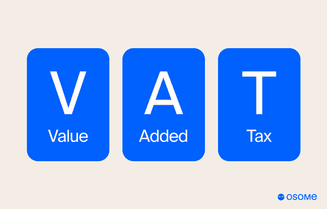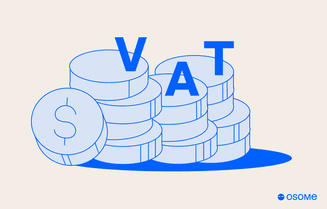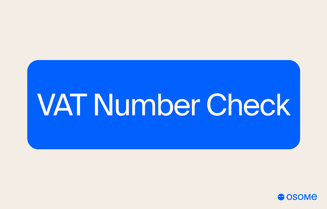What Is a VAT Number for Businesses in the UK?
- Published: 11 October 2024
- 10 min read
- Tax & VAT


Heather Cameron
Author
Heather believes in the power of great storytelling and is here to craft compelling copy that informs and inspires readers. With an extensive background in digital marketing, she has experience writing for various industries, from finance to travel. As Osome’s copywriter, Heather creates content that empowers entrepreneurs and small business owners to boost their business with expert guidance, helpful accounting tips and insights into the latest fintech trends.

Yinghua Luo
Reviewer
Yin Luo is our Operations Manager based in the UK. She keeps our UK team running like a well-oiled machine and ensures our content resonates with our British audience. Before moving to operations, Yin had over 10 years of accounting experience and is an ACCA-qualified accountant. In her current role, she is our go-to expert for making complex topics easy to understand. Yin carefully reviews our UK-focused articles, ensuring they are accurate, relevant, and packed with actionable advice to help your business thrive on this side of the pond.
Wondering what a VAT number is and when you need one? A VAT number is an identification number assigned to businesses that are registered for VAT in the UK. In this article, we’ll explain what a VAT number is, why it’s important, and how to obtain and verify it.
Key Takeaways
- VAT numbers are essential for businesses to comply with VAT regulations, typically those whose taxable turnover exceeds the registration threshold, and it helps track VAT transactions between a customer and a company within the UK.
- In the UK, businesses must obtain an identification number and register for VAT from HMRC if their taxable turnover exceeds the registration threshold. Some businesses below this threshold may choose to register voluntarily.
- Businesses can check the validity of a VAT number on the HMRC website.
What Is a VAT Number?
A VAT Number in the UK, also known as a Value Added Tax Number or VRN, uses the prefix “GB”, followed by 9 digits issued by Her Majesty's Revenue and Customs (HMRC) to businesses registered for VAT. It serves as a crucial identification number for VAT-registered businesses engaged in commercial activities within the UK.
Businesses registered for VAT are required to include their VAT number on all invoices issued for sales of goods and services. This allows for the accurate tracking and collection of added tax, a consumption tax levied at each stage of the production process, and is part of the VAT Information Exchange System used within the UK. Additionally, businesses can reclaim VAT paid on eligible purchases as long as they have valid VAT invoices from their supplier and submit an accurate VAT return.
VAT-registered businesses must display their VAT registration number on all VAT invoices from their supplier. This legal requirement ensures transparency and allows the customer to verify the legitimacy of the VAT charges and the company’s details. Additionally, the VAT registration certificate provided by HMRC serves as an official document containing the company’s VAT number. In the absence of this VAT registration certificate, businesses can find their VAT number included in the VAT returns submitted to HMRC or in their HMRC gateway account if they have registered and linked their VAT.
Struggling with VAT registration or compliance? Osome offers comprehensive accounting services to streamline your operations and ensure your business remains compliant with VAT regulations.

A VAT number in the UK is a unique identification number assigned to businesses that are registered for VAT. It is required for businesses with a taxable turnover above 90,000 or those that opt for voluntary registration. This identification number is used to track VAT payments, facilitate VAT recovery on expenses, including sales, and ensure compliance with VAT return regulations.
Structure of a VAT Number
The structure of a UK VAT number follows a specific format. VAT numbers begin with a prefix of two letters, "GB", followed by nine digits. For example, a VAT number might look like this: "GB123456789". The "GB" letters within this format indicate that the company is located in the United Kingdom.
The nine digits that follow the 'GB' prefix letters are the unique identification number for the business. These digits are assigned sequentially by HMRC when a business registers for VAT. The specific sequence of digits does not have any particular meaning or significance.
Businesses located in Northern Ireland may use different letters, 'XI', when trading with EU member states under the Northern Ireland Protocol, though the format of the VAT number remains the same. However, the overall structure of the VAT number remains the same.
By understanding the structure of a UK VAT number, you can easily identify companies that are registered for VAT and verify the authenticity of financial documents. If you are unsure of the correct format for your VAT number, it's advisable to consult HMRC or a VAT expert for format guidance.
Why Do Businesses Need a VAT Number?
The primary reason for obtaining a VAT registration number is compliance with UK tax laws. VAT is a consumption tax levied on the supply of goods and services within the UK. It is required for companies whose taxable turnover exceeds the VAT threshold (which is £ 90,000 starting April 2024) or those who choose to register voluntarily. Failure to register or comply with VAT regulations can result in significant tax penalties and fines.
It's important to note that while the Mini One Stop Shop (MOSS) scheme was abolished at the end of 2021, UK businesses selling goods or services to EU consumers must still comply with VAT regulations. This often involves registering for VAT in the relevant EU member state.

In addition to compliance, having a VAT number can offer several benefits to UK companies. It allows them to reclaim VAT on their business expenses, which can reduce their overall tax burden. Moreover, a VAT number can enhance a business's credibility and professionalism, especially when dealing with other companies or consumers.
How To Check a VAT Number Validity?
Verifying the validity of a VAT registration number is crucial to avoid potential issues with tax authorities when you register for VAT. In the UK, checking the validity of VAT numbers is a straightforward process. You can do this by using HMRC's online VAT code checker tool.
Simply visit the HMRC website and search for the VAT code checker tool, or contact them if your code needs verification. Enter the VAT number you want to verify into the provided field and click the "Check" button. The website will then display the results of the check, indicating whether the VAT number is valid or invalid.
If the VAT number is valid, the tool will provide information about the registered business, including its name and address. If the VAT number is invalid, the tool will indicate that the number is not registered.

By using this online tool, you can easily determine the validity of a UK VAT number and ensure that you are dealing with legitimate businesses. This is particularly important when conducting business transactions, as verifying the VAT number can help prevent fraud and ensure that you are dealing with a reputable company.
How To Get a VAT Number?
The process of obtaining a VAT number involves several steps, starting with understanding the VAT registration thresholds in your country. There are specific thresholds that determine when a company must register for a VAT number, including the requirement for a UK VAT registration number. For instance, the VAT registration threshold in the UK for the tax year 2024/25 is £ 90,000 in taxable turnover.
To register for VAT, businesses must submit an application to their local tax authorities using the relevant registration forms. This process typically requires providing pertinent documentation regarding the business, such as proof of business activity and evidence of the legal representative’s authority. Once the application is approved, the business will receive its VAT number, which must be used for all VAT-related transactions.

For businesses operating in Northern Ireland, the VAT registration process is similar but includes specific requirements related to trading with the EU. Understanding these requirements and ensuring compliance is crucial for smooth business operations. The VAT registration process may seem daunting, but it is a necessary step to ensure legal and efficient business practices.
How Long Does It Take To Get a VAT Number in the UK?
The typical timeframe for obtaining a valid VAT number in the UK is 30 working days. However, it's important to note that this can vary depending on several factors. If your application is straightforward and all required documents are provided accurately, you may receive your VAT number within a shorter period.
On the other hand, if HMRC requires additional information or verification, the process could take longer. In some cases, there may be delays due to high application volumes or other operational factors. It's advisable to submit your application well in advance of your expected VAT registration date to ensure that you have sufficient time for the process.
If you have concerns about the status of your VAT number application, you can contact HMRC directly for an update. They can provide information on the progress of your application and any potential delays.
How To Issue Invoices From Your VAT Number in the UK?
Issuing invoices from your VAT number in the UK is a crucial step in complying with VAT regulations. When creating an invoice, you must include certain essential details to ensure accuracy and avoid penalties.
Firstly, the invoice should clearly state the invoice number and date of the service, which are unique identifiers for each invoice. This number helps track and manage your transactions. Next, include the date of the invoice, indicating when the goods or services were provided.
The name and address of both the seller (you) and the buyer must be included on the invoice. This information helps identify the parties involved in the transaction. Additionally, the invoice should specify the quantity and description of the sales of goods or services.
A detailed breakdown of the prices is also necessary, including the net amount (excluding VAT) and the VAT amount. The total amount due, including both the net amount and VAT, should be clearly stated.
Your VAT number must be included on the invoice to indicate that you are registered for VAT and to allow the buyer to reclaim any VAT paid on business purchases.
By following these guidelines, you can ensure that your invoices comply with UK VAT regulations and avoid any potential issues with HMRC.
Handling VAT Returns
Handling VAT returns is a critical aspect of business operations, helping to ensure compliance with tax regulations. VAT numbers are essential for filing VAT returns as it allows HMRC to track payments and ensure the correct amount of tax is paid. Businesses must maintain separate accounts for input and output VAT, file VAT returns, keep transaction reports, and manage other VAT-related submissions as required by HMRC.
Timely filing and payment of the VAT return is crucial. Missing them can incur penalties. Keeping accounting software updated ensures compliance with HMRC's latest rules for VAT submissions, ensuring accurate reporting. The process of reclaiming VAT from your supplier can be tedious, often requiring detailed documentation to meet strict VAT return and tax deadlines.
Reviewing underlying transaction data to ensure correct classification is especially important for large payments or reverse charge transactions. Locking prior periods in accounting software post-submission prevents erroneous entries and maintains the integrity of a VAT return.
Accurately calculating VAT can be complex due to the differing rates applicable to various goods and services, but with diligent record-keeping and timely submissions, businesses can manage their VAT returns effectively.
Need assistance with VAT registration or compliance? Osome can provide valuable support and ensure your business remains compliant with VAT regulations. Contact us today!
Summary
Understanding and managing VAT numbers is vital for VAT-registered businesses operating within the UK. From obtaining a VAT number to verifying its validity and from filing VAT returns to addressing common issues, each step is crucial for compliance and efficient business operations. By following the guidelines and utilising the resources available, businesses can ensure they meet all VAT obligations and avoid potential pitfalls.
As we wrap up this guide, remember that staying informed and proactive about VAT regulations can save your business from unnecessary headaches and financial penalties. Keep your records accurate, stay updated on changes in VAT laws, and don’t hesitate to seek professional advice when needed. With these practices, you’ll be well-equipped to handle all aspects of VAT compliance with confidence.






